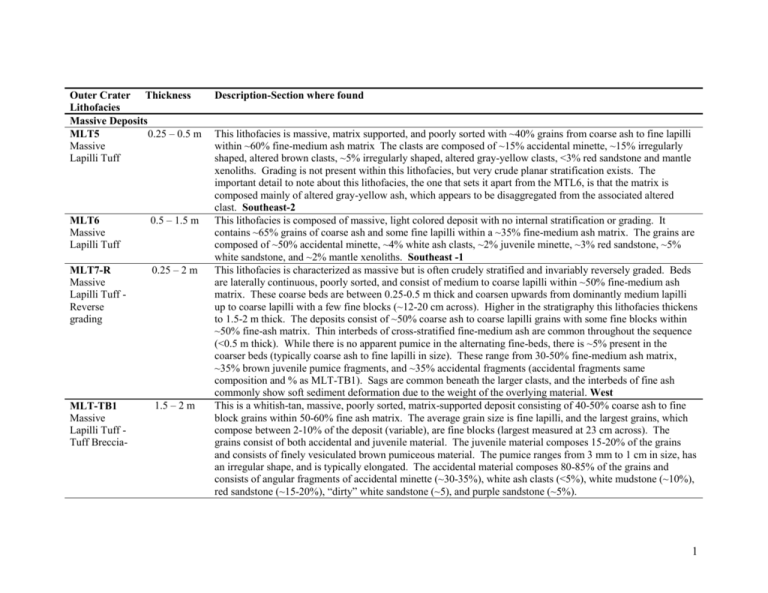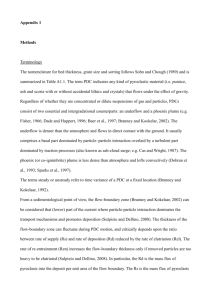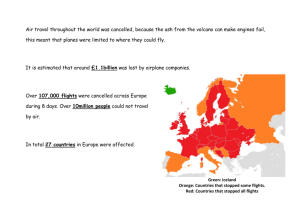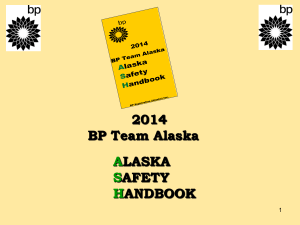Inner Crater Facies: - Springer Static Content Server
advertisement

Outer Crater Thickness Lithofacies Massive Deposits 0.25 – 0.5 m MLT5 Massive Lapilli Tuff MLT6 Massive Lapilli Tuff 0.5 – 1.5 m MLT7-R Massive Lapilli Tuff Reverse grading 0.25 – 2 m MLT-TB1 Massive Lapilli Tuff Tuff Breccia- 1.5 – 2 m Description-Section where found This lithofacies is massive, matrix supported, and poorly sorted with ~40% grains from coarse ash to fine lapilli within ~60% fine-medium ash matrix The clasts are composed of ~15% accidental minette, ~15% irregularly shaped, altered brown clasts, ~5% irregularly shaped, altered gray-yellow clasts, <3% red sandstone and mantle xenoliths. Grading is not present within this lithofacies, but very crude planar stratification exists. The important detail to note about this lithofacies, the one that sets it apart from the MTL6, is that the matrix is composed mainly of altered gray-yellow ash, which appears to be disaggregated from the associated altered clast. Southeast-2 This lithofacies is composed of massive, light colored deposit with no internal stratification or grading. It contains ~65% grains of coarse ash and some fine lapilli within a ~35% fine-medium ash matrix. The grains are composed of ~50% accidental minette, ~4% white ash clasts, ~2% juvenile minette, ~3% red sandstone, ~5% white sandstone, and ~2% mantle xenoliths. Southeast -1 This lithofacies is characterized as massive but is often crudely stratified and invariably reversely graded. Beds are laterally continuous, poorly sorted, and consist of medium to coarse lapilli within ~50% fine-medium ash matrix. These coarse beds are between 0.25-0.5 m thick and coarsen upwards from dominantly medium lapilli up to coarse lapilli with a few fine blocks (~12-20 cm across). Higher in the stratigraphy this lithofacies thickens to 1.5-2 m thick. The deposits consist of ~50% coarse ash to coarse lapilli grains with some fine blocks within ~50% fine-ash matrix. Thin interbeds of cross-stratified fine-medium ash are common throughout the sequence (<0.5 m thick). While there is no apparent pumice in the alternating fine-beds, there is ~5% present in the coarser beds (typically coarse ash to fine lapilli in size). These range from 30-50% fine-medium ash matrix, ~35% brown juvenile pumice fragments, and ~35% accidental fragments (accidental fragments same composition and % as MLT-TB1). Sags are common beneath the larger clasts, and the interbeds of fine ash commonly show soft sediment deformation due to the weight of the overlying material. West This is a whitish-tan, massive, poorly sorted, matrix-supported deposit consisting of 40-50% coarse ash to fine block grains within 50-60% fine ash matrix. The average grain size is fine lapilli, and the largest grains, which compose between 2-10% of the deposit (variable), are fine blocks (largest measured at 23 cm across). The grains consist of both accidental and juvenile material. The juvenile material composes 15-20% of the grains and consists of finely vesiculated brown pumiceous material. The pumice ranges from 3 mm to 1 cm in size, has an irregular shape, and is typically elongated. The accidental material composes 80-85% of the grains and consists of angular fragments of accidental minette (~30-35%), white ash clasts (<5%), white mudstone (~10%), red sandstone (~15-20%), “dirty” white sandstone (~5), and purple sandstone (~5%). 1 MLS1-R Massive Lapilli StoneReverse grading 0.25 – 1 m MLS-TB1-R Massive Lapilli Stone to Tuff BrecciaReverse grading 1–2m MLS2 Massive Lapilli Stone 0.5 – 2 m MTB4 Massive Tuff Breccia 2–4m Within the massive deposit are several interbedded thin (12-25 cm thick) fine-grained deposits of composed of predominately fine ash and <10% coarse ash grains. These fine-grained layers show faint to apparent cross stratification and commonly have pinch and swale structures. West This lithofacies consists of a tannish-orange, grain supported, massive deposit with crude planar stratification and common reverse grading. The grains range from medium ash to fine lapilli with a few medium-coarse lapilli (average grains size is coarse ash to fine lapilli), and is surrounded by ~10-15% fine-medium ash matrix. The grains are composed of ~30% accidental minette, 30-35% irregularly shaped altered brown clasts, ~5% red sandstone, ~3% white mudstone, ~2% white sandstone, and ~3% mantle xenoliths. No white ash clasts, irregularly shaped, pumiceous gray clasts, or juvenile minette clasts were identified. Blocks are uncommon to non-existent in these lithofacies. Southeast -2 This is a laterally continuous, massive deposits with reverse grading. It is grain supported and poorly sorted. The grains range from medium lapilli to medium blocks with ~20% fine-medium ash matrix. The grain consist of ~50-60% juvenile basalt (minette, obvious because it is scoriaceous, has an irregular shape, and has abundant phlogopite phenocrysts), ~2% brown, altered pumice, and ~20-30% accidental lithics (mostly accidental minette lithics). The average grain size at the bottom of the massive deposits is coarse lapilli, but the bed quickly coarsens upwards to an average grain size of coarse lapilli with abundant fine blocks. It is difficult to tell exactly which clasts are accidental minette and which are juvenile. It seems that the coarser the deposit gets, the more accidental minette clasts and fewer juvenile are present. Either way it is difficult to tell just from the outcrop an accurate percentage of both. West This is a dark, massive deposit with no apparent grading. It pinches and swells laterally ranging from 0.5 to 2 m thick within an individual bed. The grains range from medium ash to medium lapilli with occasional coarse lapilli to fine-medium blocks (up to 10% blocks) with ~20% fine-coarse ash matrix. Coarser grains and blocks do not display associated underlying sag structures. The grain are composed of ~60% accidental minette, ~10% white ash clasts, and ~10% mix of irregularly shaped, altered brown clasts, irregularly shaped, pumiceous gray clasts, juvenile minette, red sandstone, white sandstone, and mantle xenoliths. Southeast -1 This is a massive, poorly sorted, normal graded deposit that borders on matrix supported and grain supported, as the amount of matrix (fine-coarse ash) varies from 40-80% throughout the deposits. The grains range from coarse ash to fine blocks (up to 25% blocks). The clasts are dominated by the white ash lithics (~20-40%), and accidental minette clasts (~10-25%). Other accidentals (red sandstone and mantle xenoliths) make up ~5% of the outcrop. This lithofacies is commonly found very low in the stratigraphic section. Interbeds of coarse, crudely stratified beds from 0.05 to 0.5 m thick are common. The grain size in these 2 MTB5 Massive Tuff Breccia 4m Cross-stratified Deposits 0.5 – 2 m XLT2 Crossstratified Lapilli Tuff interbeds ranges from medium ash to fine blocks, with an average grain size of fine lapilli, within ~20% finemedium ash matrix. The grains are composed of ~20% subangular to subrounded, phlogopite bearing white ash clasts, ~55% accidental angular minette clasts, <3% peridotite and lherzolite mantle xenoliths, and <5% red sandstone and white mudstone. The white ash clasts are sometimes found crushed and appear to compose part of the matrix. The juvenile minette clasts are both angular and irregularly shaped, and tend to have glassy rinds. Some of the larger juvenile pieces contain clasts of white mudstone. East, Southeast -1 This lithofacies consists of a dark gray, massive, poorly sorted deposit with normal grading. This is a scour and fill deposit, as the base of this lithofacies appears have to erosively scoured into the underlying deposits. This channel scour and fill feature is ~7 m across at the top, and ~2 m across at the bottom. Overall it is ~4 m thick and pinches out in either direction laterally. The base of this lithofacies is a tuff breccia dominated by coarse lapilli to fine blocks within a matrix of medium-coarse ash (matrix composes 20-30% of the deposit). The deposits fines upwards into a lapilli tuff with an average grain size is fine-medium lapilli within ~40% finemedium ash matrix. The grains are composed of ~25% accidental minette, ~10% white ash clasts, ~10% juvenile minette, ~10% red sandstone, and ~5% mix of irregularly shaped, altered brown clasts, irregularly shaped, pumiceous gray clasts, white sandstone, and mantle xenoliths. Southeast -1, East This lithofacies consists of light tan-white colored, finely laminated, fine-medium grained ash. The average grain size is fine-medium ash (90-95%) with 5-10% medium to coarse ash. The grains coarse enough to be identified are composed of accidental minette, white ash clasts, and red and white sandstone. Cross strata are present and abundant at all scales from wavelengths of <1 m to 3 m. The cross strata are elongated on both the lee and stoss side, and show both lee and stoss accretion. These beds pinch and swale along with the coarse counterparts (XLT3), and commonly show soft sediment deformation due to occasional fine blocks or coarse overlying deposits. The cross strata often form climbing dunes and shoot and pool structures, and frequently climb over larger clasts and deposit coarse lags behind them. Underlying cross strata are commonly truncated. This lithofacies is laterally continuous, but commonly shows pinch and swale structures due to the crossstratification. Two interbeds are common within this lithofacies. The first interbed consists of ~50% matrix and ~50% coarse ash grains composed of ~40% accidental minette, ~4% white ash clasts, ~2% red sandstone, ~2% white sandstone, and ~2% mantle xenoliths. This interbed is on average <2 cm in thickness, but can be up to 4 cm thick. The second interbed consists of ~20% matrix and ~80% coarse ash grains composed of ~50% white ash clasts, ~10% accidental minette, and 10% other (brown clasts, red sandstone, white sandstone, mantle xenoliths). This interbed is on average 10-15 cm in thick. The abundant white ash clasts tend to abraded and very rounded. 3 Some of the white ash material has been completely disaggregated and composes sections of the matrix. East, Southeast -1 0.5 – 2 m This lithofacies is light tan-white in color and shows both wavy-planar and cross-stratification. It is very similar XLT3 Crossto XLT2, but contains much coarser grains. The grains range from coarse ash to coarse lapilli, with an average stratified grain size of fine lapilli. The wavelength of the cross strata range from 1-3 m, and the amplitude 0.25 to 1 m. Lapilli Tuff They form symmetrical to anti-dune structures, with elongation on the lee and stoss side, and both lee and stoss accretion (accretion more common on the lee side). These beds pinch and swale along with the finer counterparts (XLT2). Underlying cross strata are commonly truncated. East, Southeast -1 0.2 – 2 m This lithofacies is dark gray and consists of fairly well sorted, reversely graded beds. Individual beds range in XLS1-R Crossthickness from 20 cm to 2 m and contain abundant wavy-planar and cross-stratification. The cross strata form stratified symmetrical and anti-dune structures, with elongation on the lee and stoss side, and both lee and stoss accretion Lapilli Stone(accretion more common on the lee side). These beds pinch and swale laterally, and underlying strata is Reverse commonly truncated. The average grain size of this lithofacies is fine lapilli, but some beds contain average grading grains sizes up to coarse lapilli with some fine blocks. The matrix composes 10% of the deposits, is fines depleted, and consists of coarse ash. A few lenticular lags of coarse lapilli and fine blocks are present intermittently (5-10% fine blocks), and no sags are present beneath the larger clasts. The grains are composed of ~80-85% angular accidental minette clasts, ~5% white ash clasts, and <5% mantle xenoliths and red sandstone clasts. Little to no juvenile component is apparent on the outcrop scale. Interbeds of fine-ash beds with ~65% matrix and 35% coarse ash to fine lapilli are common. These beds show faint planar and cross stratification, and vary between 5cm-30cm thick. The grains are composed of accidental minette clasts and some white ash clasts. East Planar-stratified to massive Deposits 2 – 4 cm This lithofacies consists of ~50% matrix and ~50% coarse ash grains composed of ~40% accidental minette, T3 ~4% white ash clasts, ~2% red sandstone, ~2% white sandstone, and ~2% mantle xenoliths. It commonly occurs as an interbed within XLT2 and XLT3, and is on average <2 cm in thickness, but can be up to 4 cm thick. 1 – 1.5 m This lithofacies is poorly sorted, grain supported, massive to planar stratified, normally graded, and laterally PLT2 Planar Lapilli continuous. Grains range from coarse ash to medium lapilli, with an average grain size of fine lapilli, within Tuff ~30% fine-medium ash matrix. Grains are composed of ~40% juvenile material (finely vesiculated brown pumice), and ~30% accidental grains (same composition as PLT3). Interbeds of cross-stratified fine ash deposits (XLT2) are between 45-55 cm thick and occur every meter or so. They are composed predominantly of fine ash with <5% grains (average grain size between medium and coarse ash). West 0.5 – 1.5 m This lithofacies is very similar in composition to lithofacies PLT4-R, but it has no apparent grading. The PLT3 Planar Lapilli average grains size is coarse ash to fine lapilli within a matrix of fine-medium ash (matrix ranges from 20-40%). 4 Tuff PLT4-R Planar Lapilli Tuff- Reverse grading 0.5 – 1.5 m PLS1-R Planar StoneReverse grading 0.2 – 1.5 m PXLT1 Planar and Crossstratified Lapilli Tuff- 0.5 – 1.2 m PXLT2 0.25 – 0.5 m Fine to medium blocks of accidental clasts (mostly minette, some red sandstone) are common and compose up to 8% of the lithofacies. Grains are composed of ~35% white ash clasts, ~35% accidental minette, ~10% irregularly shaped, altered brown clasts, 5-10% irregularly shaped, pumiceous gray clasts, <2% juvenile minette, and ~5% red sandstone, white sandstone, and mantle xenoliths. Internal planar stratification varies from 2-10 cm thick. The grain size within the planar stratification alternates from fine lapilli, medium lapilli, and coarse lapilli. However, the average grain size of the lithofacies as a whole is medium lapilli. The main difference between this lithofacies and lithofacies PLT4-R is that this lithofacies has no apparent grading and consists of equal amounts of the accidental minette and white ash clasts. They tend to alternate from which is more dominant from one layer to the next. These individual layers range from 1-5 cm thick. Also different is the presence of the irregularly shaped, sometimes very finely vesiculated gray and brown clasts. These were found below in a very small amount, but are much more abundant in this part of the section. East, Southeast -1 This lithofacies consists of dark gray, reverse graded, planar stratified beds of coarse ash to coarse lapilli within a fine-medium ash matrix (matrix composes 20-30% of deposit). Fine blocks are common in this lithofacies and compose 2-10% of the section (highly variable). The deposit is composed of ~20-30% matrix, ~50% white ash clasts, ~15% accidental minette, ~10% juvenile minette, ~5% red sandstone, ~2% white sandstone, and ~2% mantle xenoliths. It ranges from 0.5 to 1. 5m thick, and the internal planar stratification varies from 2-10 cm thick. The grain size within the planar stratification alternates from fine lapilli, medium lapilli, and coarse lapilli. However, the average grain size of the lithofacies as a whole is medium lapilli. East, Southeast -1 This lithofacies consists of dark gray, reversely graded and grain supported beds of coarse ash to coarse lapilli within ~20% medium ash matrix. The beds coarsens up to an average grain size of medium-coarse lapilli. The deposit is composed of <20% matrix, ~45% minette angular accidental clasts, ~30% subrounded white ash clasts, and ~5% red sandstone and mantle xenolith clasts. The average grain size at the base of individual beds typically coarse ash to fine lapilli, but coarsens upward to medium-coarse lapilli. Both planar and cross stratification are common within these deposits. The main difference between this lithofacies and PLT4-R and PLT3 is the clast composition. East, Southeast -1 This lithofacies is matrix supported (70% fine-medium ash matrix) and contains bedding structures that range from massive, crudely stratified, planar stratified, and wavy-planar stratified. Cross-stratification is rare but also occasionally present. Grains range from medium ash to fine lapilli with some floating medium-coarse lapilli. The average grains size is coarse ash to fine lapilli. The deposits consist of 70% fine-medium ash matrix, ~10% accidental minette, ~10% irregularly shaped, altered brown clasts, 10% irregularly shaped, pumiceous gray clasts, ~4% mix of red sandstone, white mudstone, white sandstone, and mantle xenoliths. No white ash clasts or juvenile minette were identified on the outcrop scale. East, Southeast -2 This lithofacies is orange-brown, fine-grained, and finely laminated with beds consisting of ~60-70% fine ash 5 Planar and Crossstratified Lapilli Tuff PXLT3 Planar and Crossstratified Lapilli Tuff- matrix, and 30-40% coarse ash-fine lapilli grains composed of ~15% accidental minette, ~10% red sandstone, and ~5-10% white sandstone. Wavy-planar and cross-stratification common. This lithofacies commonly alternates with beds of PXLT1 East, Southeast -2 0.25 – 0.5 m PXLS1-R Planar and Crossstratified Lapilli StoneReverse grading Scoriaceous Deposits MAG-1 1–3m Magmatic Tva 2–5m Tvb 2–5m Tvc 1–3m This lithofacies consists of wavy-planar stratified deposits of ~40% matrix, and 60% grains of medium ash to medium lapilli (average grain size coarse ash to fine lapilli). The grains are composed of 35% accidental minette, ~20% white ash clasts, ~5% white sandstone, red sandstone, and mantle xenoliths. Blocks are common and compose between 1-8% of the beds. This lithofacies is often distinguished by a sharp color change from gray (below, PXLT1) to orange. This contact is laterally continuous and can be traced some distance until no longer exposed. East This lithofacies is compositionally the equivalent to lithofacies PXLT1, but has less matrix, is coarser, thicker, and is reversely grading. It is well sorted and grain supported (average grain size of fine lapilli ) with 10-20% fine-medium ash matrix. A few floating coarse lapilli clasts are present, but comprise <2% of the lithofacies. Southeast -2 This lithofacies contains large blocks of juvenile material. It begins with ~20-30% fine ash matrix, 70-80% juvenile fragments, and <10% accidental fragments (white mudstone, white sandstone, red sandstone, angular clasts of trachybasalt, and peridotite xenoliths). Several fine-coarse blocks (up to 2m across, 2m tall) are present. The base of these blocks are broken and fractured, and a small sag structure is common. Accidental blocks of hypabyssal minette and sedimentary wallrock are surrounded by juvenile magma, which is evidenced by the glassy rind around the outside (cord bomb), as well as the large chunks of darker gray vesiculated minette around it. It appears as if part of they were partially molten when emplaced, while part was significantly solidified (angular around some edges). Also, in places the pyroclastic rock and juvenile magma appear to be intermixed. East, Southeast -1 Tva is an aphanitic extrusive minette with phenocrysts of olivine, clinopyroxene, and phlogopite 1-3 mm in diameter (Ehrenberg, 1978). Tvb is compositionally identical to Tva, but is a coarser-grained lava with a groundmass of sanidine crystals 0.51 mm in diameter that poikilitically enclose the ferromagnesian minerals (Ehrenberg, 1978). Tvc, the youngest unit, is an aphanitic, greenish-grey felsic minette lava with phenocrysts of phlogopite and 6 Ti ? diopside in a trachytic groundmass of feldspar laths (Ehrenberg, 1978). The rock exhibits bands and marbling that may be indicative of magma mixing. Upon eruption, Tvc carried abundant nodules of spinel peridotite and subordinate websterite and granulite; most near the surface of the flow were subsequently altered and eroded, leaving voids. Remnant xenoliths now compose about 5% of Tvc visible in outcrops (Ehrenberg, 1978). Two plugs of aphanitic mafic minette and one cluster of dikes and scoriaceous rubble are found within the crater (Figures 1b, 6a, and 6c; labeled Ti by Ehrenberg, 1978). The plugs have columnar jointing and are generally nonvesicular except in their uppermost parts. This nonvesicular mafic minette is petrographically and compositionally similar to the oldest lava Tva (Ehrenberg, 1978). 7






